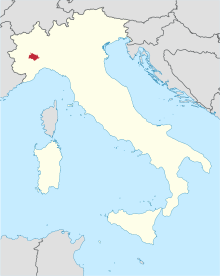Bishopric of Asti
|
Diocese of Asti Dioecesis Astensis |
|
|---|---|

Asti Cathedral
|
|
| Location | |
| Country | Italy |
| Ecclesiastical province | Turin |
| Statistics | |
| Area | 1,451 km2 (560 sq mi) |
| Population - Total - Catholics |
(as of 2015) 162,257 152,000 (est.) (93.7%) |
| Parishes | 126 |
| Information | |
| Denomination | Catholic Church |
| Rite | Roman Rite |
| Established | 3rd century |
| Cathedral | Cattedrale di S. Maria Assunta |
| Secular priests | 94 (diocesan) 32 (Religious Orders) 12 Permanent Deacons |
| Current leadership | |
| Pope | Francis |
| Bishop | Francesco Guido Ravinale |
| Map | |
 |
|
| Website | |
| www.webdiocesi.chiesacattolica.it | |
The Diocese of Asti (Latin: Dioecesis Astensis) is a Roman Catholic ecclesiastical territory in Piedmont, northern Italy, centered in the city of Asti. It has been a suffragan of the Archdiocese of Turin since 1515. Previous to that, it was a suffragan of the Archdiocese of Milan.
The diocese lost territory in 1175, when the diocese of Alessandria was created. It lost a considerable amount of its ancient territory when the diocese of Mondovì was established in 1388 by Urban VI. It lost territory again when the diocese of Casale was created in 1474, and again in 1511 at the creation of the diocese of Saluzzo. In 1592 the diocese of Fossano was assigned more of Asti's territory.
There has been some controversy as to the beginning of the Diocese of Asti and the episcopate of St. Evasius, once placed by some at much earlier dates. The diocese of Asti itself fixes the beginning of the diocese in the 5th century.
Scholars have suggested that more than one figure came to melt into the tale of St. Evasius, thus making it extremely difficult to use the existing material as an historical source. The situation is so confused that some historians list five different Saint Evasiuses. Lanzoni notes a purported Evasius in 261, another in 364, a third in 389, a fourth in 419, and the fifth in the time of King Liutprand (712–744). A catalogue of bishops of Asti, written in 1606, assigns him a date of 783.
The first known bishop of Asti was Pastor in 451. Bishop Audax (904-926) obtained the confirmation of the liberties of the Church of Asti from King Berengarius, and was a friend of Rudolph of Burgundy. He sought to have his Canons called "cardinals", as they were at S, Eusebio in Vercelli.
The bishops of Asti were feudatory vassals of the Holy Roman Empire and of the Counts (Dukes) of Savoy. In turn, they were feudal overlords of fiefs belonging to Corveglia, Castellinaldo, Montaldo Roero, Monteu Roero, Piea, Monticelli, Pocapaglia, Govone, Vezza, Cellarengo, S. Vittoria, S. Stefano Roero, Piobesi, Magliano, Cossombrato, Castagnito. and Castellino de Voltis.
Also subject to the Bishop of Asti were the abbeys of Santi Apostoli, S. Anastasio and S. Cristoforo in the city of Asti; S. Bartolomeo de Azano, and S. Dalmazio de Pedona. The bishops had also been given the monastery of S. Maria de Caramania in the diocese of Turin by Pope Calixtus II (1119–1124). There was a house of the Knights Templar in Asti, called the Domus Hospitalis Soldani, as early as 1182; it belonged to the Lombard province, and came to an end, along with the Templars, in 1312.
...
Wikipedia
